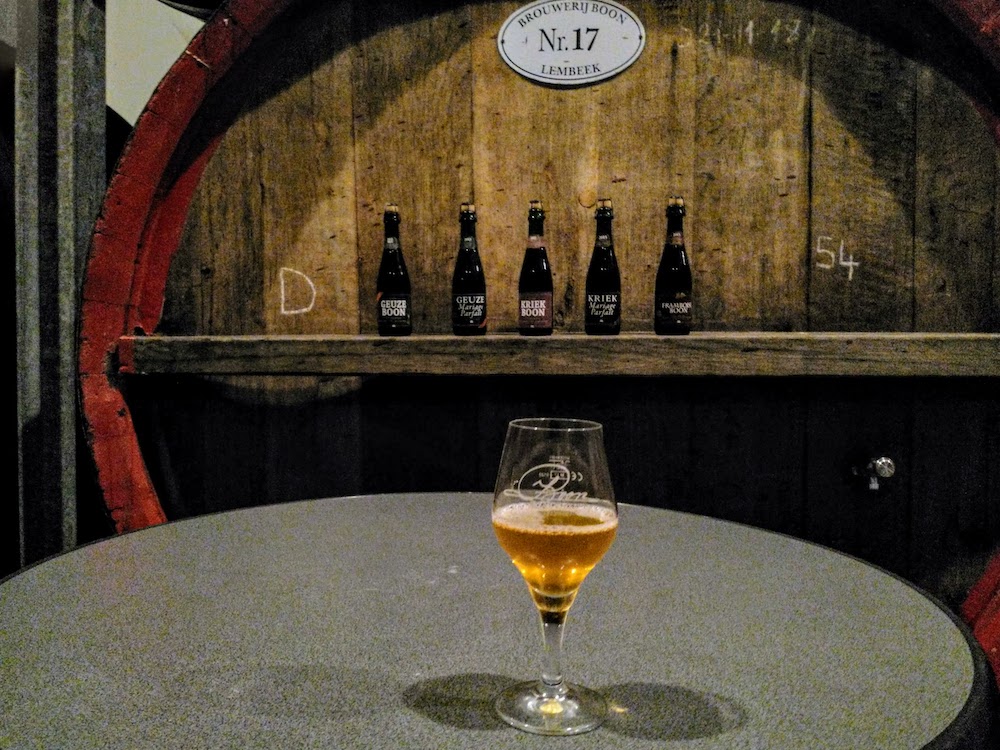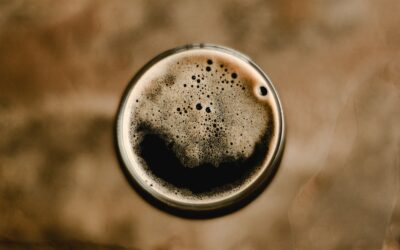Classified correctly, lambics can be seen as beer’s ‘third way’. While lagers are fermented by one strain of cultured yeast and ales by another, lambics utilise naturally occurring yeast, harvested from the night sky.
Lambic beers are brewed in Brussels and Payottenland, the mixed suburban-rural area to its West. They have no known parallels in brewing history, though they derive from the wheat beer tradition of central Europe.
They are brewed from malted barley and at least 40% unmalted wheat, using aged hops. The wild yeast are gathered by pouring sweet wort into a large shallow vessel called a koelschip (literally cooling vessel), and allowing it to cool overnight while air blows over it. In the morning, the cool, inoculated wort is run into large oak casks, where it goes on to ferment for anything up to three years.
While lying in its cask in the first few weeks of life, naturally occurring saccharomyces yeast cause a fairly vigorous primary fermentation. Lactobacilli and pediococci bacteria then take over, bringing a sharp lactic tang and citrus edges, before slow-acting Brettanomyces yeast strains begin to influence flavours and aromas in the second and third year.
Draught lambic is the base beer for a whole family of variants, created by steeping and blending. It is considered young in its first twelve months or so, and matured in its second and third years.
These simple brews of unusual character were for centuries the workaday beers of the Bruxellois, earning today’s producers a Traditional Speciality Guaranteed (TSG) protection order within the EU. The terms ‘Oud / Oude’ and ‘Vieil /Vieille’, which translate roughly as ‘Authentic’, may only be applied to lambic beers that have been made to tightly prescribed traditional methods.
The principle difference between lambic beers and other sour, wild and fruit beers, is their multi-layered degree of sophistication.
Oude / Vieille (authentic) lambic
Oude Lambic (4.5-6.0% ABV) is the building block from which the family of lambic beers are created. It is brewed between October and March as a wheat beer, using a large quantity of old hops that have lost their aroma, flavour and bitterness but retain their antioxidant properties. After brewing is complete, the resulting wort cools overnight (as above) in a shallow vessel, attracting microorganisms to its sticky surface. Most lambic is used to produce other styles in the lambic family of beers, but it can sometimes be found on draught, mostly in the area where it is produced. After six months in its cask it tastes much like a musty version of a cask-conditioned ale, while a fully matured one will be more wine-like and typically flat.

A glass of oude lambic at Brouwerij Boon in Halle, Belgium (photo: André Brunnsberg)
Faro
The original principle of Faro (4.5-6.0% ABV) was that a small amount of sugar was added to a draught lambic to provoke further conditioning and take the lactic edge away. Most modern Faro is bottled, representing a youngish lambic, sweetened with brown sugar to create a slightly musty session beer that tends to be darker than regular lambic. It is still possible to find a few such beers on draught in a handful of cafés in Brussels and Payottenland.
Oude / Vieille (authentic) gueuze
Oude Gueuze (5.0-8.0% ABV), sometimes Geuze, or Vieille Gueuze, is perhaps the most striking original beer style in the world. Approach it unprepared and it may shock or confuse. The best of these pour clear and in their flavours feature shards of tangy citrus against a sharp background, offset by rustic and musty aromas. Describing the character of Oude Gueuze in beery term does not work. It is better to see it as a sophisticated form of dry, spritzy drink, akin to sparkling wine or the finest dry ciders, with grain substituted for fruit. Oude Gueuze is made by blending draught lambics from different seasons, then bottling the blend in Champagne-style bottles, with a drop of liquid sugar to prompt some refermentation. The bulk of the blend is young lambic, 6 to 12 months old, with the character coming from smaller slugs of beer that has aged for two or three years. The best have aromas of ‘old bookshop’, ‘hay barn, or ‘horse blanket’. Unquestionably it is an acquired taste, but one that once acquired is rarely lost. Further, in acquiring it, your understanding of the world may well expand a little.
Oude (authentic) kriek
Oude Kriek (5.0-8.0% ABV) is another extraordinary drink. It is made by steeping a large volume of whole cherries, with their stones, in a large cask of lambic for between four and 12 months. The best cherries tend to be harder, slightly bitter varieties, and their addition has numerous effects. Their fructose and glucose spark refermentation, while any residual unfermentable sugars can add a little sweetness; their skins bring an impressive deep red colour; cherry flavours and aromas shine through; and more subtly the stones bring almond-like elements. Even the most heavily cherried, in which fruit will take up 40% of the space in the cask, will end dry to tart. Oude Kriek is thought to be as old as lambic itself, the habit of adding fruit being another way of adding value to a fruit harvest that is notoriously short and can produce a glut. Its allure and rarity have sent prices sky-rocketing in recent years but have also underwritten its once fragile future, as the finest style of fruit beer in the world. Note that beers labelled Kriek, without the word ‘Oude’ in their name, are from different and usually far less impressive traditions.
Framboise / Framboos
The other fruit that has long been added to lambic to form its own beer style is the raspberry. Framboise (5.0-7.0% ABV), or Framboos in Flemish dialect, is not protected in law, simply because at the time the protection was granted, very few authentic examples remained. The principles are much as for Oude Kriek, with whole fruit being significantly superior to juice, and incomparably better than syrup or extract. The fruit is less easy to handle, for the lack of stones, and the colour fades fairly swiftly, though its delicacy is a great asset. Sadly, most beers bearing the name Framboise are made by adding syrup to industrial lambic or other beers.
Other fruit lambics
There are examples on the market of top producers making authentic lambics by steeping whole apricots, blackberries, red and white grapes, plums, strawberries and other fruits, though there are far more examples of these being made from syrup and industrial beer.
Industrial lambics
Mid-20th century corporate thinking concluded that the emerging public taste for simple, sweet things was a permanent change, so beers from a folk-craft tradition were often replaced with cartoon versions. Where lambics were concerned, the result was a generation of beautifully presented, sticky-sweet, underpowered drinks retaining the name but few of the characteristics. These are easily accessible and unusual drinks, which will likely last a little longer, but they do not showcase proper lambic brewing.





